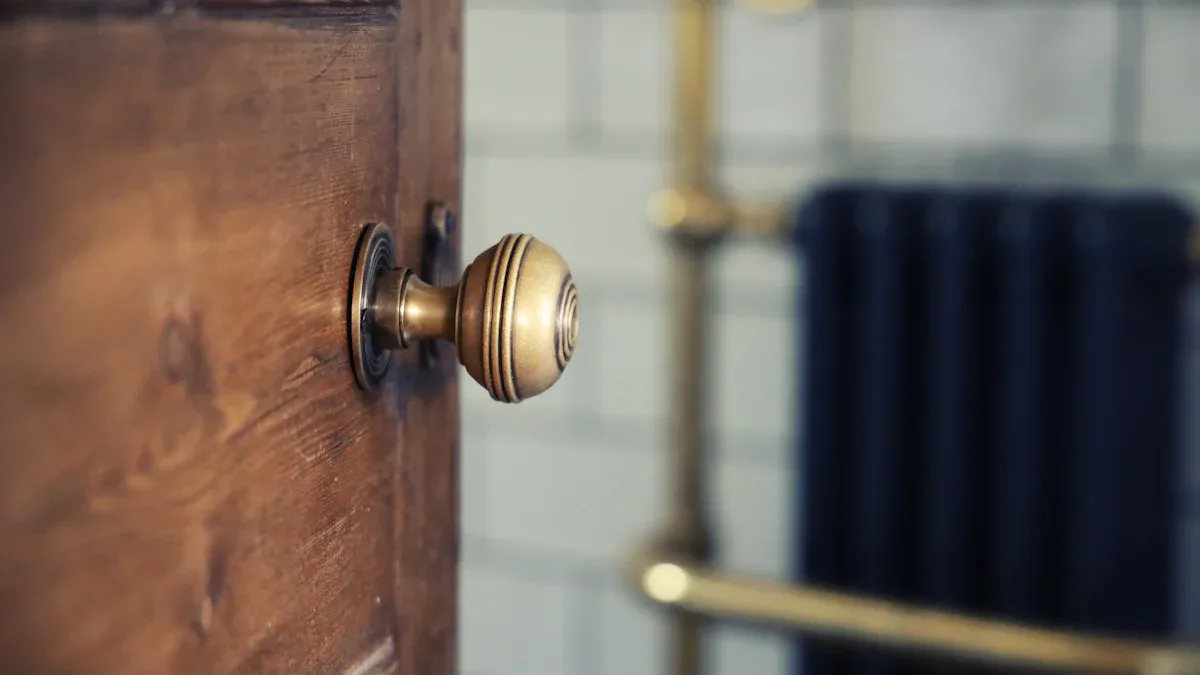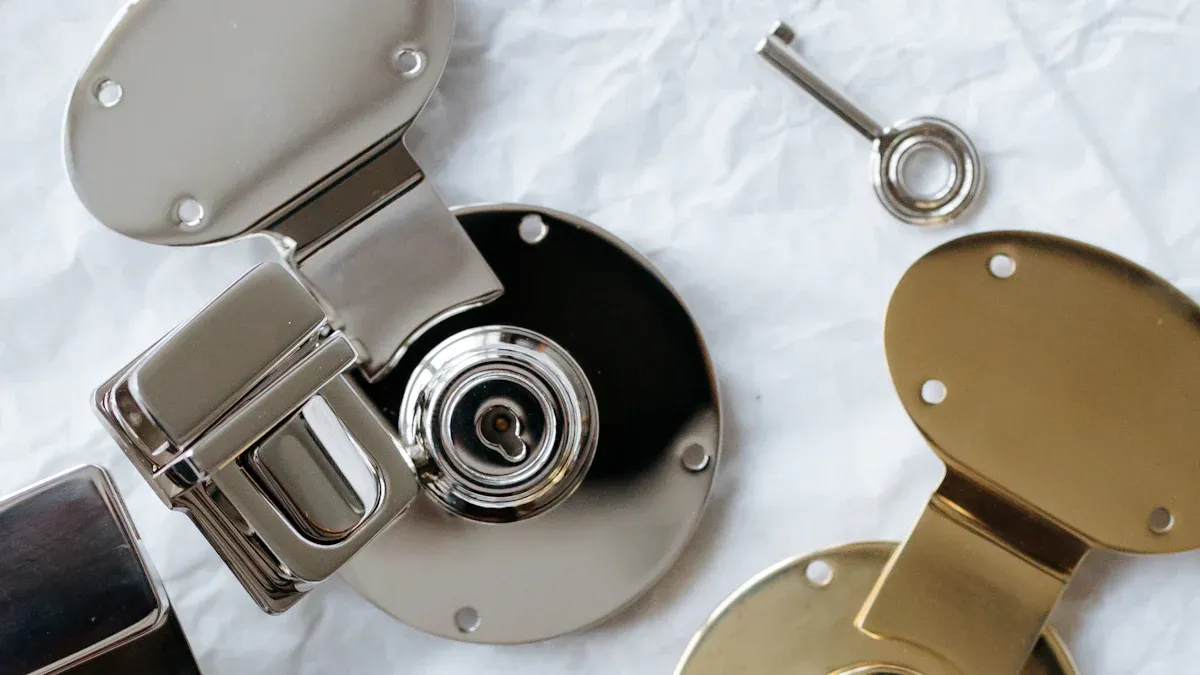

Views: 0 Author: Site Editor Publish Time: 2025-07-28 Origin: Site










If you want your brass door knobs to shine and look new, you can use simple homemade tricks or commercial cleaners. People polish brass door knobs to remove tarnish from pollution and keep that bright look. Always check if your knob is solid brass or plated before starting. Learning how to clean brass is easy, safe, and works for everyone. You can also find matching steel door accessories for a complete upgrade.
Check if your door knob is solid brass or brass-plated before you clean it. This helps you pick the right way to clean and stops damage.
Use soft, natural cleaners like lemon juice, vinegar, or brass polish to clean off tarnish. Always rinse and dry the knob well after you clean it.
Keep your brass knobs shiny by cleaning them often. Do not use strong chemicals. You can also put on coatings or wax to help them stay shiny longer.

Before you start, you need to know if your brass door knobs are solid brass or just brass-plated. This makes a big difference in how to clean brass and which products you should use. Solid brass knobs feel heavier and smoother than plated ones. They resist corrosion better and often show small color or texture changes, which many people love for their handcrafted look. Brass-plated knobs usually have a base metal like steel or aluminum under a thin brass layer. If you see spots where the finish has worn off, you might notice a different color underneath.
You can try a few simple tests at home:
Use a magnet. Brass is not magnetic, so if the magnet sticks, your knob is not solid brass.
Try the scratch test. Scratch a hidden spot gently. If you see shiny yellow metal, it’s solid brass. If another color appears, it’s plated.
Compare the weight. Solid brass door knobs feel much heavier than steel or aluminum knobs of the same size.
Tip: If you have valuable or antique hardware, ask an expert before testing.
Once you know what type of knob you have, you can gather your supplies. For homemade brass cleaning methods, you probably have most items in your kitchen. Here’s what you’ll need:
Mild dish soap and warm water
Lemons and salt
Vinegar and salt
Ketchup
For commercial cleaning, you can pick up these products:
Bar Keepers Friend (BKF) powder or liquid
Brasso Metal Polish
Wright’s Brass Polish
Soft cloths and non-abrasive sponges
Soft-bristled toothbrush
Gloves and goggles for safety
You can find these supplies at most stores, and they work well for both brass door knobs and other door accessories. If you’re upgrading your home, consider matching your brass hardware with a new steel door for a fresh look. Now that you have your materials, you’re ready to learn how to clean brass and keep your hardware looking its best.

You want your brass door knobs to look their best, so start by removing them from the door if possible. This makes it easier to reach every spot and keeps your door safe from drips. Use a screwdriver to take off the knob and any faceplates. Place the screws in a small bowl so you don’t lose them.
Before you begin, gather your safety gear. Here’s what you should use:
Gloves to protect your hands from chemicals and tarnish.
Goggles to keep splashes away from your eyes.
A face mask if you use strong cleaners.
Always read the labels on any commercial cleaner. Never use bleach or harsh solvents, as these can damage the brass or its coating. Stick with soft cloths and avoid abrasive pads or steel wool. If you use homemade solutions, measure ingredients carefully. Too much acid from lemon juice or vinegar can harm the finish.
Now, wash the knob with warm water and mild dish soap. Use a microfiber cloth to wipe away dirt and oils. Rinse with distilled or filtered water to avoid spots. Dry the knob right away with a clean towel.
You have several options for polishing, depending on how much tarnish you see. If you want to know how to clean brass doorknobs with natural methods, try these:
Cleaning Method | Effectiveness | Usage Details | Safety & Handling |
|---|---|---|---|
Lemon Juice & Baking Soda | Effective for light tarnish; gentle and eco-friendly | Dip half a lemon in baking soda, rub on brass, let sit 5-10 minutes, rinse, buff | Safe, easy to use, fresh scent |
Vinegar & Salt Paste | Great for heavy tarnish; needs longer time | Mix vinegar, salt, and flour into a paste, apply, let sit 30-60 minutes, rinse, buff | Safe, but avoid over-scrubbing |
Ketchup | Mild acid removes tarnish; easy for quick jobs | Spread ketchup on knob, wait 10-15 minutes, rinse, buff dry | Safe, but sticky—rinse well |
Commercial Brass Polish | Best for deep tarnish and high shine | Apply with soft cloth, rub in circles, follow directions, buff to shine | Wear gloves, avoid skin contact |
If you want the best way to clean brass, start with lemon juice and baking soda for light tarnish. For heavy tarnish, use a vinegar and salt paste. Apply the paste with a soft cloth or toothbrush, rub gently, and let it sit. For a quick fix, ketchup works well because of its natural acids. You can also clean brass with toothpaste for small spots—just rub a little on, let it sit, then rinse and buff.
If you prefer commercial products, clean brass with brass polish like Brasso or Wright’s. These give a mirror finish and work fast on tough stains. Always wear gloves and work in a well-ventilated area.
Tip: Never use abrasive tools or harsh chemicals. They can scratch or strip the finish, especially on brass-plated knobs.
After you polish, rinse the knob with warm distilled water. This removes any leftover cleaner or paste. Dry the knob right away with a soft, lint-free cloth. Buff the surface in small circles to bring out the shine. If you want extra protection, rub a drop of olive oil or beeswax on the knob and buff again. This helps prevent future tarnish.
Here’s a quick checklist for rinsing and buffing:
Rinse thoroughly with warm water.
Dry immediately with a microfiber towel.
Buff in circles with a clean, dry cloth.
Optionally, apply a thin layer of olive oil or beeswax for extra shine.
Sometimes, regular cleaning does not remove all the tarnish. If you still see dark spots, try these tricks:
Use a special brass polish like Brasso or Wright’s for deep stains.
Make a thick paste from flour, vinegar, and salt. Rub it on, let it sit for up to an hour, then buff off.
For small areas, clean brass with yoghurt or non-gel toothpaste. Both contain mild acids that lift tarnish. Rub gently, let sit, then rinse and buff.
For very tough spots, soak the knob in a bowl lined with aluminum foil, filled with warm water, salt, and baking soda. Let it sit for 5-10 minutes, then rinse and dry.
If your knob is lacquered, avoid all abrasive or acidic cleaners. Just dust with a microfiber cloth and wipe with mild soapy water. Dry right away.
Note: Never soak brass-plated knobs for long periods. The plating can peel or chip. Always test a small area first.
If you want to know how to clean brass doorknobs in an eco-friendly way, stick with natural ingredients like lemon, vinegar, and baking soda. These work well, cost less, and are safer for your home and the environment. Commercial cleaners can contain strong chemicals, so use them only when needed and always follow safety instructions.
You can use these steps for other door accessories too, like hinges or handles. Hele Doors offers a wide range of steel door and fire door options that pair well with polished brass hardware, giving your entryway a fresh, modern look.
By following these steps, you now know how to clean brass, how to clean brass doorknobs, and the best way to clean brass for a lasting shine.
You want your brass door knobs to stay shiny for as long as possible. Cleaning and polishing them every few months keeps them looking great. If your home is in a humid area or near the coast, you might need to clean brass hardware more often. Moisture, air pollution, and even the oils from your hands can speed up tarnishing.
Here are some ways to protect your brass:
Use coatings like Everbrite Protective Coating or ProtectaClear. These seal the brass and stop tarnish, fingerprints, and corrosion. They do not yellow or darken, even in sunlight.
Try a clear lacquer or a thin layer of wax. Both create a barrier against air and moisture. Wax needs reapplying, but it is easy to buff for extra shine.
Store extra knobs in a dry place and wrap them in a soft cloth.
Avoid harsh chemicals and minimize touching the knobs with bare hands.
Environmental Factor | Effect on Brass Tarnishing |
|---|---|
Humidity and Moisture | Speeds up oxidation and tarnish, especially in coastal or damp areas. |
Air Pollution | Sulfur in the air causes dark spots and faster tarnishing. |
Skin Oils and Acids | Leaves residue that leads to uneven discoloration. |
Household Chemicals | Breaks down protective coatings and increases tarnish. |
Tip: After cleaning, always dry your brass knobs completely to prevent moisture buildup.
Brass-plated door knobs need gentle care. The brass layer is thin, so you should avoid scrubbing or using abrasive cleaners. Wipe them with a soft, damp cloth and dry them right away. If you polish too often or too hard, you might wear away the brass and expose the metal underneath.
For solid brass, you can polish and clean brass hardware without worry. Solid brass is durable and can handle regular cleaning. Brass-plated knobs, though, need a light touch. If the plating or lacquer starts to peel or crack, you may need a professional to refinish them.
If you want your entryway to look even better, consider pairing your polished brass knobs with a new steel door or fire door from Hele Doors. This combination gives your home a modern and secure upgrade.
You can polish brass door knobs easily by following these steps: clean, apply a natural paste, let it sit, rinse, dry, and buff. Regular care keeps them shiny and helps reduce germs. With simple tools, you get lasting results. Try matching your hardware with a steel door or fire door for a fresh look.
You should polish your brass door knobs every three to six months. If you live in a humid area, check them more often for tarnish.
You can use commercial polish, but test a small spot first. Brass-plated knobs need gentle care to avoid wearing down the thin brass layer.
You can clean hinges, handles, and even the hardware on your steel door or fire door using the same steps for brass door knobs.
